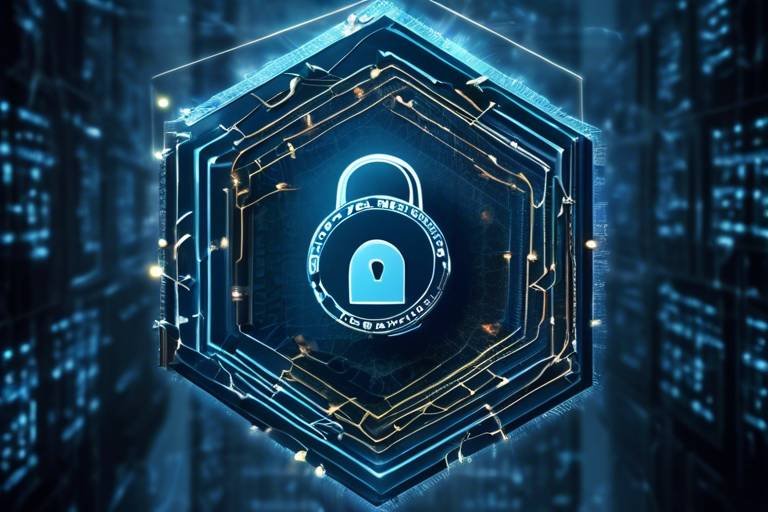Understanding the Security Challenges in Blockchain Development
As we dive into the world of blockchain technology, it's essential to grasp the security challenges that come with it. Blockchain, often hailed as a revolutionary technology, offers a myriad of benefits, including transparency, decentralization, and immutability. However, these advantages do not come without their fair share of vulnerabilities. In fact, the very characteristics that make blockchain appealing can also expose it to various security threats. So, what exactly are these challenges, and how can developers navigate through them?
To start, let's consider that blockchain systems are essentially a collection of interconnected nodes that maintain a shared ledger. This decentralized nature can create a false sense of security, leading developers to underestimate potential risks. For instance, while the data stored on a blockchain is immutable, the systems that interact with it—like wallets and exchanges—are not immune to attacks. It's crucial for developers to understand that the security of a blockchain application is only as strong as its weakest link.
Moreover, the rapid evolution of blockchain technology means that many developers are still catching up with the best practices and security measures necessary for creating safe applications. This creates an environment ripe for exploitation, where attackers can take advantage of unpatched vulnerabilities or poorly designed smart contracts. Understanding these security challenges is not just about protecting data; it's about safeguarding the trust that users place in blockchain systems.
In this article, we will explore the common vulnerabilities that plague blockchain development, the various threats that can compromise security, and best practices that developers can adopt to ensure a secure blockchain environment. By arming ourselves with knowledge and awareness, we can contribute to a more secure blockchain landscape that fosters innovation while protecting users and their assets.
Blockchain systems are not immune to vulnerabilities. This section discusses the most prevalent security flaws that developers encounter and how they can impact the integrity of blockchain applications.
Various threats can compromise blockchain security. This section examines the most significant threats, including hacking attempts, insider threats, and social engineering tactics that target blockchain systems.
Smart contracts, while revolutionary, come with inherent risks. This part delves into common vulnerabilities within smart contracts and the implications of poorly written code on overall blockchain security.
Reentrancy attacks pose a serious risk to smart contracts. This subsection explains how these attacks work and the measures developers can implement to mitigate them.
Logic flaws in smart contracts can lead to unintended consequences. This section outlines common logic errors and best practices for ensuring robust contract design.
The security of the underlying network is crucial for blockchain integrity. This section highlights potential vulnerabilities in blockchain networks and strategies to enhance their security.
Implementing best practices is essential for securing blockchain applications. This section outlines key strategies developers should adopt to minimize risks and enhance the overall security of their projects.
Conducting regular security audits is vital for maintaining blockchain integrity. This subsection discusses the importance of audits and how they can help identify vulnerabilities before they are exploited.
Educating developers about security challenges is crucial. This section emphasizes the need for ongoing training and awareness programs to equip teams with the skills necessary to develop secure blockchain solutions.
- What are the main security challenges in blockchain development? - The main challenges include vulnerabilities in smart contracts, network security issues, and the risks of social engineering attacks.
- How can developers mitigate security risks? - Developers can mitigate risks by conducting regular audits, implementing best coding practices, and staying informed about the latest security threats.
- Are smart contracts inherently secure? - No, while smart contracts offer automation and trust, they can have vulnerabilities if not coded correctly.
- What is a reentrancy attack? - A reentrancy attack is a type of exploit where an attacker repeatedly calls a smart contract before the previous execution is complete, potentially draining funds.

Common Vulnerabilities in Blockchain
Blockchain technology, while revolutionary and promising, is not without its flaws. Just like any other system, it has its share of vulnerabilities that developers must address to maintain the integrity and security of their applications. One of the most significant issues is the inadequate implementation of cryptographic algorithms. If these algorithms are poorly designed or improperly executed, it can lead to unauthorized access and data breaches. Imagine locking your front door with a flimsy lock; it might look secure, but a determined intruder can easily bypass it.
Another common vulnerability is the lack of proper access controls. In a decentralized environment, determining who has access to what can be tricky. If access controls are not strictly enforced, unauthorized users may gain access to sensitive data or even alter the blockchain. This is akin to leaving the keys to your house under the welcome mat—anyone can come in if they know where to look!
Moreover, software bugs are a prevalent issue in blockchain development. Just like any software, blockchain applications can have coding errors that can be exploited. A famous example is the infamous DAO hack, where a bug in the smart contract code led to the loss of millions of dollars. Developers must rigorously test their code and ensure that they follow best practices to mitigate such risks.
Additionally, network vulnerabilities present another layer of risk. Blockchain networks rely on a peer-to-peer architecture, which can be susceptible to attacks such as Distributed Denial of Service (DDoS). In a DDoS attack, a malicious actor floods the network with traffic, overwhelming it and preventing legitimate users from accessing the blockchain. This disruption can have severe implications for businesses relying on blockchain technology.
Lastly, insider threats cannot be overlooked. Employees or developers with access to the blockchain can intentionally or unintentionally compromise security. Whether it's through negligence or malicious intent, insider threats can be just as damaging as external attacks. To combat this, organizations must implement stringent security protocols and conduct thorough background checks on personnel.
In summary, while blockchain technology offers immense benefits, it is crucial to recognize and address its vulnerabilities. By understanding these common flaws, developers can take proactive steps to protect their applications and ensure a secure blockchain environment.
- What are the main vulnerabilities in blockchain technology? The main vulnerabilities include inadequate cryptographic implementations, lack of access controls, software bugs, network vulnerabilities, and insider threats.
- How can I protect my blockchain application from vulnerabilities? Regular code audits, implementing strong access controls, and using well-established cryptographic algorithms can help protect your application.
- What is a DDoS attack? A Distributed Denial of Service attack involves overwhelming a network with traffic, making it difficult for legitimate users to access the blockchain.
- Why are smart contracts vulnerable? Smart contracts can have coding errors or logic flaws that may be exploited, leading to significant vulnerabilities in the blockchain.

Threats to Blockchain Security
When we think about blockchain, we often envision a world of secure transactions and decentralized power. However, the reality is that blockchain technology is not impervious to threats. In fact, various vulnerabilities can compromise the integrity and security of blockchain systems. It's crucial to understand these threats to develop effective strategies for mitigating them. So, what are the most significant threats lurking in the shadows of blockchain security?
One of the most alarming threats is hacking attempts. Cybercriminals are constantly looking for ways to exploit weaknesses in blockchain systems. These hackers may target wallet addresses, exchange platforms, or even the blockchain itself. Their goal? To siphon off funds or manipulate data. It’s like a digital heist, where the stakes are incredibly high, and the criminals are becoming increasingly sophisticated in their methods.
Another serious concern is the risk of insider threats. This can stem from employees or contractors who have access to sensitive information or systems. Imagine a trusted team member deciding to exploit their access for personal gain. Insider threats can be particularly damaging because they come from within, making them harder to detect and prevent. Organizations must implement strict access controls and monitoring systems to mitigate this risk.
Additionally, social engineering tactics pose a significant threat to blockchain security. These tactics often involve manipulating individuals into divulging confidential information or granting unauthorized access. For example, a hacker might impersonate a trusted colleague or use phishing emails to trick users into revealing their private keys. It's a bit like a magician pulling a rabbit out of a hat—only instead of a rabbit, it’s sensitive information that can lead to devastating consequences.
Moreover, the rise of 51% attacks is a major concern for blockchain networks. In a 51% attack, a single entity or group gains control of more than half of the network's mining power. This allows them to manipulate transactions, double-spend coins, or prevent others from making transactions. It's akin to a monopoly in the digital realm, where one party can dictate the rules to their advantage, undermining the very principles of decentralization.
To further illustrate the various threats to blockchain security, consider the following table:
| Threat Type | Description | Potential Impact |
|---|---|---|
| Hacking Attempts | Cybercriminals exploit vulnerabilities to steal funds or manipulate data. | Financial loss, data integrity issues. |
| Insider Threats | Trusted individuals misuse their access for malicious purposes. | Data breaches, financial loss, reputational damage. |
| Social Engineering | Manipulating individuals into providing confidential information. | Unauthorized access, data theft. |
| 51% Attacks | Control of over half the network's mining power to manipulate transactions. | Loss of trust, financial instability. |
In conclusion, understanding the threats to blockchain security is essential for anyone involved in blockchain development or investment. By recognizing these risks, developers and organizations can take proactive measures to safeguard their systems and ensure a secure blockchain environment. The digital landscape is ever-evolving, and staying informed about potential threats is the first step in fortifying blockchain security.
- What is a 51% attack? A 51% attack occurs when a single entity gains control of more than half of a blockchain network's mining power, allowing them to manipulate transactions.
- How can I protect my blockchain assets? Use secure wallets, enable two-factor authentication, and stay vigilant against phishing attempts.
- What are insider threats? Insider threats are risks posed by trusted individuals who may misuse their access to sensitive information or systems for malicious purposes.

Smart Contract Risks
Smart contracts are often hailed as the cornerstone of blockchain technology, bringing automation and efficiency to a myriad of applications. However, just like a shiny new car, they come with their own set of risks. The beauty of smart contracts lies in their ability to execute transactions automatically when certain conditions are met, but this very feature can also expose them to vulnerabilities that can be exploited by malicious actors. Understanding these risks is crucial for developers and businesses alike, as even a minor oversight in code can lead to catastrophic financial losses.
One of the most significant risks associated with smart contracts is the potential for coding errors. Unlike traditional contracts that can be amended or negotiated, smart contracts are immutable once deployed. This means that any bugs or vulnerabilities in the code can be exploited indefinitely. For instance, a simple typo could allow an attacker to drain funds from a contract. Developers need to be meticulous in their coding practices, as the stakes are incredibly high.
Moreover, smart contracts are often designed to interact with other contracts and decentralized applications. This interconnectedness can create a domino effect where a vulnerability in one contract can compromise the security of others. Imagine a chain reaction where one faulty contract brings down an entire ecosystem. This is why thorough testing and auditing are essential before deployment.
Another critical aspect to consider is the risk of reentrancy attacks. This type of attack occurs when a malicious actor exploits a function in a smart contract that allows them to repeatedly call it before the previous execution is completed. For example, if a smart contract allows users to withdraw funds, an attacker could call the withdraw function multiple times in quick succession, draining the contract of its funds. To mitigate this risk, developers can implement strategies such as using mutexes or checks-effects-interactions patterns to ensure that the state changes are completed before any external calls are made.
Additionally, logic flaws can lead to unintended consequences that may not be immediately apparent. These flaws arise when the logic implemented in the smart contract does not align with the intended functionality. For instance, a contract designed to distribute tokens could mistakenly allow users to claim more tokens than they are entitled to, leading to financial discrepancies. To avoid such pitfalls, developers should engage in rigorous testing, including unit tests and simulation of various scenarios to ensure that the contract behaves as expected.
In summary, while smart contracts offer incredible potential, they are not without their risks. Developers must remain vigilant, continuously educating themselves about the evolving landscape of threats and vulnerabilities. By adopting best practices, such as thorough testing, regular audits, and a deep understanding of the underlying technology, they can significantly reduce the risks associated with smart contracts. After all, in the world of blockchain, a single line of code can be the difference between security and disaster.

Reentrancy Attacks
Reentrancy attacks are a notorious threat in the world of smart contracts, and understanding them is crucial for anyone involved in blockchain development. Imagine a scenario where a thief takes advantage of a poorly secured door that allows them to enter a house, grab valuables, and sneak out before the owner even realizes what's happening. In the blockchain realm, this "thief" can exploit the contract's functions, leading to devastating financial losses.
At its core, a reentrancy attack occurs when a smart contract calls an external contract and that external contract makes a recursive call back to the original contract before the first execution is complete. This can create a situation where the contract's state is altered unexpectedly, allowing the attacker to drain funds or manipulate data. The infamous DAO hack in 2016 is a prime example of such an attack, where the attacker exploited a reentrancy vulnerability to siphon off millions of dollars in Ether.
To illustrate how reentrancy works, consider the following simplified example:
contract Vulnerable {
mapping(address > uint) public balances;
function withdraw(uint amount) public {
require(balances[msg.sender] > amount);
balances[msg.sender] - amount; // State change before external call
msg.sender.call.value(amount)(""); // External call
}
}
In this example, if an attacker controls the address that calls the `withdraw` function, they can recursively call this function multiple times before the balance is updated, effectively draining the contract's funds. This is why it is essential for developers to be aware of such vulnerabilities.
To mitigate the risk of reentrancy attacks, developers can implement several strategies:
- Use the Checks-Effects-Interactions Pattern: Always check conditions, then update the state, and finally interact with external contracts. This ensures that any state changes occur before external calls.
- Utilize Mutexes: Implement a mutex (mutual exclusion) to prevent reentrant calls from the same contract.
- Limit External Calls: Minimize the number of external calls made within your contracts, especially in sensitive functions like withdrawals.
By employing these best practices, developers can significantly reduce the risk of reentrancy attacks and enhance the overall security of their smart contracts. Remember, in the rapidly evolving world of blockchain technology, staying informed and proactive is key to safeguarding your projects.

Logic Flaws
When it comes to blockchain development, are like hidden traps waiting to ensnare unsuspecting developers. These flaws occur when the code doesn’t behave as intended, leading to unintended consequences that can compromise the entire system. Imagine constructing a house with a faulty blueprint; no matter how well you build, if the foundation is flawed, the structure will eventually crumble. Similarly, logic flaws in smart contracts can lead to disastrous outcomes, such as financial losses or unauthorized access to sensitive data.
One common example of a logic flaw is a misconfigured access control. This occurs when the contract allows users to execute functions that should be restricted. For instance, if a contract is designed to allow only the owner to withdraw funds but mistakenly grants that permission to all users, it could lead to a complete drain of the contract’s assets. Such oversights can be devastating, especially in high-stakes environments where millions of dollars are at risk.
Another frequent pitfall arises from incorrect assumptions made by developers. They might assume that certain conditions will always be met, only to find out later that those conditions can be manipulated. For example, a contract might depend on the order of transactions being processed in a specific way. If an attacker can manipulate the transaction order, they could exploit this flaw to their advantage. This is similar to a game of chess; if one player can predict and manipulate the opponent’s moves, they can easily win the game.
To help developers avoid these pitfalls, here are some best practices to consider:
- Thorough Testing: Implement comprehensive testing protocols, including unit tests and integration tests, to ensure that all aspects of the contract function as intended.
- Peer Reviews: Encourage code reviews among team members to catch potential logic flaws before deployment. A fresh set of eyes can often spot issues that the original developer might overlook.
- Formal Verification: Consider using formal verification methods to mathematically prove that the smart contract behaves as expected under all conditions.
By integrating these practices into the development process, teams can significantly reduce the risk of logic flaws. It’s essential to remain vigilant and proactive, as the landscape of blockchain technology is constantly evolving. As new vulnerabilities are discovered, developers must adapt and enhance their coding strategies to safeguard their projects.

Network Security Concerns
When it comes to blockchain technology, one cannot overlook the significance of network security. The very foundation of blockchain relies on a decentralized network, which, while offering numerous advantages, also presents a unique set of vulnerabilities. Imagine a bustling city where every street is a pathway for information; if one street is compromised, the entire city could be at risk. Similarly, if a single node within a blockchain network is breached, it could potentially jeopardize the integrity of the entire system.
One of the primary concerns in blockchain networks is the threat of Distributed Denial of Service (DDoS) attacks. These attacks can overwhelm network nodes with excessive requests, causing legitimate transactions to be delayed or even dropped entirely. Such disruptions not only frustrate users but can also lead to significant financial losses and damage to the network's reputation. To put it simply, a DDoS attack is like a traffic jam caused by too many cars on the road, preventing anyone from reaching their destination.
Another critical aspect of network security is the risk of man-in-the-middle attacks. In this scenario, an attacker intercepts communication between two parties within the network, potentially altering the information being exchanged without either party realizing it. This type of attack can lead to unauthorized transactions and a loss of trust in the network. To visualize this, think of it as someone eavesdropping on a private conversation and manipulating the dialogue to their advantage. The implications can be catastrophic.
Moreover, the use of outdated software or unpatched vulnerabilities in network nodes can create significant security holes. Just like a house with broken locks is an easy target for burglars, a blockchain network with outdated security protocols is vulnerable to attacks. It’s crucial for developers and network administrators to ensure that all software is regularly updated and patched to protect against known vulnerabilities.
To enhance network security, developers should consider implementing the following strategies:
- Regular Software Updates: Keeping software up-to-date ensures that any known vulnerabilities are patched promptly.
- Network Monitoring: Continuous monitoring of network activity can help detect unusual patterns that may indicate an attack.
- Access Controls: Implementing robust access controls can minimize the risk of unauthorized access to network nodes.
In conclusion, addressing network security concerns is paramount for the success and reliability of blockchain technology. By recognizing potential vulnerabilities and implementing best practices, developers can create a more secure environment that fosters trust and integrity. Just as a well-guarded city thrives, so too can a robust blockchain network flourish when its security is prioritized.
Q1: What are the main security risks in blockchain networks?
A1: The main security risks include DDoS attacks, man-in-the-middle attacks, and vulnerabilities due to outdated software.
Q2: How can developers enhance blockchain network security?
A2: Developers can enhance security by regularly updating software, monitoring network activity, and implementing strict access controls.
Q3: Why is network security crucial for blockchain technology?
A3: Network security is crucial because any breach can compromise the integrity of the entire blockchain, leading to financial losses and a loss of trust.

Best Practices for Secure Blockchain Development
When it comes to developing blockchain applications, ensuring security is not just an option; it’s a necessity. With the increasing prevalence of cyber threats, developers must adopt best practices that fortify their applications against potential vulnerabilities. One of the most effective strategies is to conduct regular security audits. These audits are essential for identifying weaknesses in the code and infrastructure before malicious actors can exploit them. Think of it like a routine health check-up for your application; it helps you catch issues early and maintain a robust system.
In addition to audits, education and training play a crucial role in enhancing security. Developers should be well-versed in the latest security challenges and best practices. This ongoing education can take many forms, from workshops to online courses, ensuring that teams are equipped with the knowledge they need to create secure blockchain solutions. By fostering a culture of security awareness, organizations can significantly reduce the risk of human error, which is often the weakest link in the security chain.
Another vital practice is to implement thorough testing procedures during the development phase. This includes unit testing, integration testing, and even penetration testing. By simulating attacks and identifying vulnerabilities in a controlled environment, developers can address issues before the application goes live. Additionally, utilizing automated testing tools can streamline this process, allowing for more comprehensive coverage and quicker identification of potential flaws.
Moreover, it’s essential to establish a clear governance framework for blockchain projects. This framework should outline roles, responsibilities, and protocols for security management. By having a structured approach, organizations can ensure that everyone involved in the development process understands the importance of security and follows established guidelines. This can help prevent miscommunication and reduce the likelihood of security oversights.
To further enhance security, developers should consider adopting multi-signature wallets for managing funds within the blockchain. Multi-signature wallets require multiple private keys to authorize a transaction, adding an extra layer of security. This means that even if one key is compromised, unauthorized access to funds remains unlikely. It’s a bit like needing several keys to unlock a vault; it drastically reduces the chances of theft.
Lastly, keeping software and dependencies up to date is crucial. Vulnerabilities are often discovered in libraries and frameworks, and failing to update can leave a system exposed. Developers should implement a process for regularly checking for updates and patches, ensuring that their applications are protected against known vulnerabilities.
- What are the most important best practices for blockchain security?
Regular audits, ongoing education, thorough testing, clear governance frameworks, multi-signature wallets, and keeping software updated are key practices. - How often should security audits be conducted?
Security audits should be conducted regularly, ideally at different stages of development and after significant changes to the code. - Why is developer education important for blockchain security?
Educated developers are more aware of potential threats and best practices, reducing the risk of human error which can lead to vulnerabilities.

Regular Audits
When it comes to maintaining the integrity of blockchain applications, are not just a good practice—they're essential. Think of an audit as a health check-up for your blockchain system. Just like you wouldn't ignore a persistent cough, you shouldn't overlook potential vulnerabilities in your blockchain. Regular audits help identify weaknesses before they can be exploited, ensuring that your application remains robust and secure.
Audits can take many forms, from automated tools that scan for common vulnerabilities to in-depth manual reviews by security experts. These audits typically focus on various aspects of the blockchain, including smart contracts, network configurations, and cryptographic implementations. By systematically evaluating these components, developers can uncover hidden flaws that might otherwise go unnoticed.
Moreover, the fast-paced nature of blockchain technology means that new vulnerabilities are constantly emerging. Just as you would regularly update your antivirus software to protect against the latest threats, your blockchain system needs to undergo frequent audits to stay ahead of potential risks. This proactive approach not only protects your investment but also builds trust with users, stakeholders, and investors.
Here are a few key benefits of conducting regular audits:
- Identifying Vulnerabilities: Regular audits can pinpoint security gaps, allowing developers to address them promptly.
- Enhancing Compliance: Many industries require adherence to specific regulations. Audits can help ensure compliance with these standards.
- Building Trust: Demonstrating a commitment to security through regular audits can enhance user confidence in your blockchain application.
In conclusion, regular audits are a critical component of secure blockchain development. By making audits a routine part of your development process, you can significantly reduce the risk of security breaches and ensure that your blockchain remains a safe and reliable platform for users.
- What is a blockchain audit? A blockchain audit is a comprehensive evaluation of a blockchain system's security, performance, and compliance with relevant standards.
- How often should I conduct audits? It's recommended to conduct audits regularly, ideally after significant updates or changes to the system, and at least annually.
- Who should perform the audits? Audits should ideally be conducted by experienced security professionals or firms specializing in blockchain technology.

Education and Training
In the rapidly evolving world of blockchain technology, are not just beneficial; they are absolutely essential. With the landscape constantly changing, developers and stakeholders must stay informed about the latest security challenges and best practices. Think of it like a race: if you’re not training regularly, you’ll fall behind. The same goes for blockchain developers; without continuous learning, they risk creating vulnerabilities in their projects.
To effectively tackle security challenges, organizations should implement comprehensive training programs that cover various aspects of blockchain security. This includes understanding common vulnerabilities, recognizing potential threats, and learning how to write secure smart contracts. For instance, a well-structured training program could cover topics such as:
- The fundamentals of blockchain technology
- Identifying and mitigating risks in smart contracts
- Best practices for network security
- Awareness of social engineering tactics
Moreover, regular workshops and seminars can help keep teams updated on the latest security trends and threats. Imagine a ship navigating through stormy seas; the crew must be well-trained and prepared to handle any situation that arises. Similarly, developers need to be equipped with the knowledge and skills to address security issues before they escalate.
Additionally, organizations should encourage a culture of continuous education. This could involve providing access to online courses, certifications, and resources that focus on blockchain security. By investing in their teams, companies not only enhance their security posture but also foster a sense of loyalty and commitment among employees. After all, when people feel valued and empowered, they are more likely to contribute positively to the organization’s goals.
Finally, it’s crucial to create a feedback loop where developers can share their experiences and learnings about security challenges. This collaborative approach not only enhances individual skills but also strengthens the entire team’s capability to tackle potential threats. In essence, education and training should be viewed as an ongoing journey rather than a one-time event. As the saying goes, “Knowledge is power,” and in the realm of blockchain security, this couldn’t be more accurate.
Q1: Why is education important for blockchain developers?
A1: Education equips developers with the necessary skills to identify and mitigate security vulnerabilities, ensuring the integrity of blockchain applications.
Q2: What topics should be covered in blockchain security training?
A2: Topics should include common vulnerabilities, smart contract security, network security best practices, and awareness of social engineering tactics.
Q3: How can organizations foster a culture of continuous education?
A3: Organizations can provide access to online courses, hold regular workshops, and encourage knowledge sharing among team members.
Frequently Asked Questions
- What are the common vulnerabilities in blockchain development?
Blockchain systems can face various vulnerabilities, including issues like smart contract flaws, network attacks, and data integrity problems. These vulnerabilities can significantly impact the security and reliability of blockchain applications, making it crucial for developers to be aware of them.
- How can threats compromise blockchain security?
Threats such as hacking attempts, insider threats, and social engineering tactics can undermine blockchain security. These threats exploit weaknesses in the system, potentially leading to unauthorized access or data breaches. It's essential to implement robust security measures to counter these threats.
- What are smart contract risks?
Smart contracts, while innovative, are not without risks. Common vulnerabilities include reentrancy attacks and logic flaws, which can have serious implications for blockchain security. Poorly written code can result in unintended consequences, making it vital for developers to follow best practices.
- What are reentrancy attacks?
Reentrancy attacks occur when a smart contract calls another contract before finishing its execution. This can allow the attacker to manipulate state variables and drain funds. Developers can mitigate this risk by using techniques such as checks-effects-interactions and reentrancy guards.
- How can logic flaws affect smart contracts?
Logic flaws in smart contracts can lead to unexpected behavior and financial losses. These flaws often arise from incorrect assumptions or overlooked scenarios. To prevent such issues, developers should conduct thorough testing and code reviews, ensuring robust contract design.
- What network security concerns should developers be aware of?
The underlying network's security is crucial for maintaining blockchain integrity. Potential vulnerabilities include 51% attacks and Sybil attacks. Developers should focus on enhancing network security through measures like decentralization and consensus algorithms.
- What are the best practices for secure blockchain development?
Implementing best practices is key to securing blockchain applications. Strategies include conducting regular security audits, providing education and training for developers, and adopting a security-first mindset throughout the development process.
- Why are regular audits important for blockchain security?
Regular security audits help identify vulnerabilities before they can be exploited. They provide a comprehensive assessment of the system's security posture, allowing developers to address potential issues proactively and maintain the integrity of the blockchain.
- How can education and training improve blockchain security?
Educating developers about security challenges is crucial for building secure blockchain solutions. Ongoing training and awareness programs equip teams with the skills needed to recognize vulnerabilities and implement effective security measures.



















